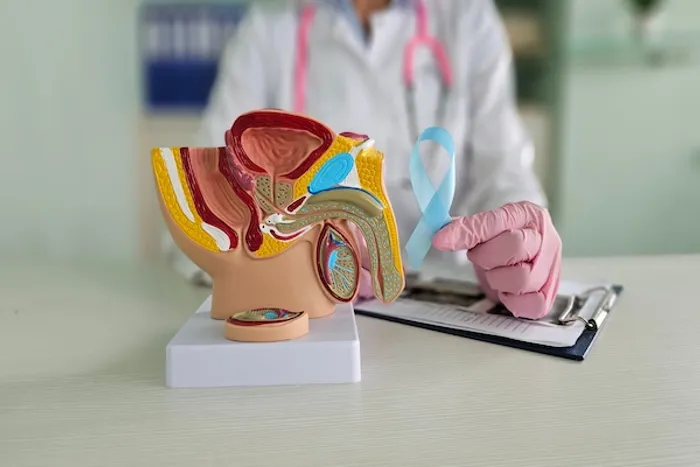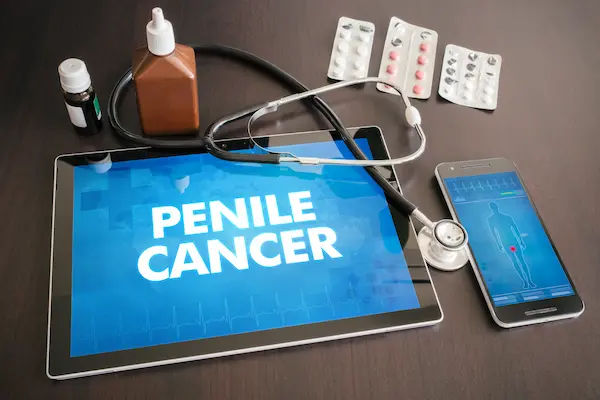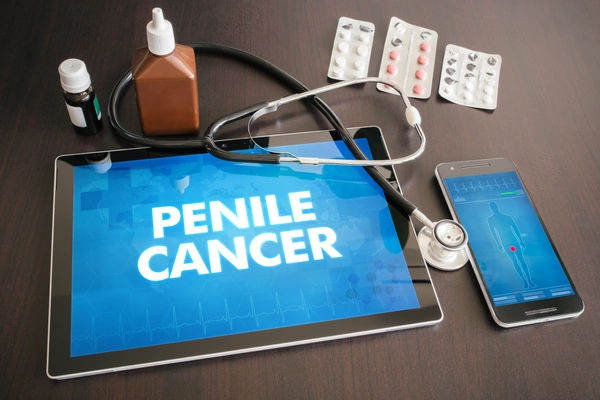Penile Cancer Signs: Causes, Symptoms, and Early Detection
Know about penile cancer signs, causes, symptoms, early detection and prevention of cancer.


Introduction
Noticing an unusual change in your penis can be alarming. While most changes are benign, understanding what leads to the signs of penile cancer is a critical step for any man's health. This cancer, though rare, is highly treatable when caught early. The challenge often lies in the silence of its initial stages and the hesitation to discuss intimate health concerns. This article will demystify penile cancer, breaking down its causes, the specific symptoms to watch for, and the biological mechanisms that lead to them. We'll move from the first subtle signs to the underlying risk factors, empowering you with knowledge for early detection and prevention. Your health is paramount, and being informed is your first line of defense.
Understanding Penile Cancer: A Brief Overview
Penile cancer is a rare malignancy that occurs when abnormal cells grow uncontrollably in the tissues of the penis. The most common type, accounting for over 95% of cases, is squamous cell carcinoma, which begins in the thin, flat skin cells on the surface of the penis. It most frequently develops on the glans (the head of the penis) or under the foreskin in uncircumcised men. While its overall prevalence is low, the impact on quality of life and mental well-being can be significant, making awareness crucial. The positive news is that its progression is often slow, and with high vigilance, it can be identified at a stage where treatment is most effective, often leading to a full cure.
Consult a Top Oncologist for Personalised Advice
The Most Common Signs and Symptoms of Penile Cancer
Recognising the early signs of penile cancer is the single most important factor in successful treatment. Symptoms can vary, but they typically involve visible and tangible changes to the penile skin.
Visible Changes on the Penis
The first warning signs are usually visual. You might notice a growth, sore, or area of skin that looks different and doesn't go away. This could appear as:
- A lump or wart-like bump that may be small or large.
- An ulcer (sore) that might bleed or crust over.
- A flat, bluish-brown patch or a reddish, velvety rash.
- Thickening of the skin on the penis, altering its texture.
- Unusual discharge or bleeding from under the foreskin.
Sensations and Pain
Sometimes, physical sensations accompany the visual cues. This includes:
- Persistent itching or a burning sensation on the penis.
- Pain or tenderness in the penis itself.
- A noticeable change in the colour of the penile skin.
Advanced Symptoms
If the cancer progresses without treatment, symptoms may become more severe, indicating it has spread.
These include:
- An enlarging lump in the groin due to swollen lymph nodes.
- Unexplained weight loss, fatigue, and general body aches.
If you notice any persistent lump or lesion on the penis, it is essential to seek medical evaluation. If symptoms persist beyond two weeks, consult a doctor online with Apollo24|7 for further evaluation and to discuss the need for a physical examination.
What Leads to These Signs? The Root Causes and Mechanisms
The signs of penile cancer are the result of cellular damage and uncontrolled growth. Several key factors can initiate this damaging process.
The Role of Human Papillomavirus (HPV)
Infection with certain high-risk strains of HPV (particularly HPV-16 and HPV-18) is one of the strongest risk factors for penile cancer. HPV is a common sexually transmitted infection. In some men, the virus can integrate into the DNA of penile skin cells, causing them to produce proteins that disrupt normal cell cycle controls. This interference can lead to uncontrolled cell division and, eventually, the formation of a cancerous squamous cell carcinoma lesion. Studies suggest that HPV is detected in nearly 50% of all penile cancer cases.
Chronic Inflammation and Skin Conditions
Long-term irritation and inflammation can cause repeated damage to skin cells, increasing the chance of errors during cell replication.
Phimosis and Poor Hygiene
Phimosis (a condition where the foreskin is too tight to be pulled back over the glans) makes proper cleaning difficult. This can lead to the buildup of smegma, a thick, cheese-like substance that can cause chronic irritation and inflammation. This constant state of irritation is a known catalyst for cellular changes that can lead to cancer.
Lichen Sclerosus and Other Precancerous Conditions
Lichen sclerosus is a chronic skin condition that causes white, patchy skin that is thinner than normal. It can affect the genital area and, over many years, carries a small risk of developing into penile cancer. Other precancerous conditions, like Bowen's disease or Erythroplasia of Queyrat, present as red, scaly patches on the penis and are considered direct precursors to invasive cancer if left untreated.
Lifestyle Factors: Smoking and Its Direct Impact
Smoking is a major independent risk factor for penile cancer. Carcinogens from tobacco are absorbed into the bloodstream and can become concentrated in urine. For uncircumcised men, these carcinogens can be trapped under the foreskin, bathing the glans in cancer-causing chemicals for prolonged periods, significantly increasing the risk of cellular damage.
Age and Weakened Immune System
Penile cancer is most commonly diagnosed in men over 50. A naturally ageing immune system may be less effective at identifying and destroying abnormal cells. Furthermore, men with weakened immune systems—such as those with HIV/AIDS or those taking immunosuppressive drugs after an organ transplant—have a substantially higher risk of developing various cancers, including penile cancer, as their bodies are less equipped to fight off oncogenic viruses like HPV.
How is Penile Cancer Diagnosed?
Diagnosis begins with a clinical assessment. If your doctor suspects an issue, they will recommend the following steps to confirm whether a lump or lesion on the penis is cancerous.
Physical Examination and Medical History
A doctor will carefully examine the penis, groin, and lymph nodes for any abnormalities. They will ask about your health history, including any history of HPV, skin conditions, smoking, and sexual health.
The Biopsy: The Only Definitive Test
The only way to confirm a diagnosis of penile cancer is through a biopsy. A small sample of tissue is removed from the abnormal area and sent to a lab, where a pathologist examines it under a microscope for cancer cells. Apollo24|7 offers convenient home collection services for various tests, and while a biopsy requires a clinical procedure, your doctor can guide you through the entire process, including sending samples for analysis.
Imaging Tests for Staging
If cancer is confirmed, imaging tests like an MRI, CT scan, or ultrasound may be used to determine the "stage" of the cancer—how deep it has grown and if it has spread to lymph nodes or other organs. This information is crucial for planning the most effective treatment for cancer on the penis.
Prevention: Reducing Your Risk Factors
While not all cases are preventable, you can significantly reduce your risk.
- HPV Vaccination: The HPV vaccine (Gardasil 9) is highly effective at preventing infection from the high-risk HPV strains most commonly linked to penile, anal, and throat cancers. It is recommended for preteens but can be administered to adults up to age 45.
- Practising Good Genital Hygiene: For all men, but especially those who are uncircumcised, regularly cleaning the penis, including gently retracting the foreskin to wash the glans with warm water, is essential to prevent smegma buildup and chronic inflammation.
- The Importance of Regular Self-Exams: Get familiar with the normal look and feel of your penis. Perform monthly self-exams to check for any new lumps, sores, colour changes, or textures. Early detection is everything.
- Quit Smoking: Eliminating tobacco use reduces your exposure to powerful carcinogens.
Conclusion
Understanding what leads to the signs of penile cancer empowers you to take proactive control of your health. The journey from a risk factor like HPV or chronic inflammation to a visible symptom involves cellular changes that often happen over years. This provides a crucial window of opportunity for prevention and early intervention. The most important message is to overcome any hesitation or stigma. Your health is too important. Familiarise yourself with the normal state of your body, adopt preventive measures like good hygiene and consider HPV vaccination, and most importantly, seek professional medical advice for any persistent, unexplained change. If your condition does not improve after trying these methods, or if you have any concerning symptoms, book a physical visit to a doctor with Apollo24|7. Timely action can make all the difference, leading to effective treatment and an excellent prognosis.
Consult a Top Oncologist for Personalised Advice
Consult a Top Oncologist for Personalised Advice

Dr. Rupam Manna
Radiation Specialist Oncologist
4 Years • MBBS MD(RADIO THERAPY)
Barasat
Diab-Eat-Ease, Barasat

Dr Ved Bhaskar
Urologist
11 Years • MBBS, MS (Gen Surgery), MCh (Urology), Fellowship in Robotic Surgery
Lucknow
Apollomedics Super Speciality Hospital, Lucknow

Dr. Prashant Chandra Das
Surgical Oncologist
15 Years • MBBS (MKCG Medical college) MCh (Surgical Oncology, Kidwai memorial institute of Oncology, Bangalore) MS (General Surgery, BHU Varanasi) Fellowship in Minimal Access Surgery ( FMAS). ESSO Course On Minimally Invasive Esophagectomy & Gastrectomy (UMC, Utrecht, Netherlands). Trained in Robotic and Laparoscopic Cancer Surgery.
Bhubaneswar
Apollo Hospitals Old Sainik School Road, Bhubaneswar
(25+ Patients)

Dr. Swati Shah
Surgical Oncologist
15 Years • DNB Surgical Oncology, certified Robotic Cancer Surgeon
Ahmedabad
Apollo Hospitals Gandhinagar, Ahmedabad
(25+ Patients)

Dr. Shashikant Gupta
Urologist
13 Years • MS (General Surgery),MCh (Urology & Renal Transplant)
Lucknow
Apollomedics Super Speciality Hospital, Lucknow
(50+ Patients)
Consult a Top Oncologist for Personalised Advice

Dr. Rupam Manna
Radiation Specialist Oncologist
4 Years • MBBS MD(RADIO THERAPY)
Barasat
Diab-Eat-Ease, Barasat

Dr Ved Bhaskar
Urologist
11 Years • MBBS, MS (Gen Surgery), MCh (Urology), Fellowship in Robotic Surgery
Lucknow
Apollomedics Super Speciality Hospital, Lucknow

Dr. Prashant Chandra Das
Surgical Oncologist
15 Years • MBBS (MKCG Medical college) MCh (Surgical Oncology, Kidwai memorial institute of Oncology, Bangalore) MS (General Surgery, BHU Varanasi) Fellowship in Minimal Access Surgery ( FMAS). ESSO Course On Minimally Invasive Esophagectomy & Gastrectomy (UMC, Utrecht, Netherlands). Trained in Robotic and Laparoscopic Cancer Surgery.
Bhubaneswar
Apollo Hospitals Old Sainik School Road, Bhubaneswar
(25+ Patients)

Dr. Swati Shah
Surgical Oncologist
15 Years • DNB Surgical Oncology, certified Robotic Cancer Surgeon
Ahmedabad
Apollo Hospitals Gandhinagar, Ahmedabad
(25+ Patients)

Dr. Shashikant Gupta
Urologist
13 Years • MS (General Surgery),MCh (Urology & Renal Transplant)
Lucknow
Apollomedics Super Speciality Hospital, Lucknow
(50+ Patients)
More articles from Penile Cancer
Frequently Asked Questions
Is penile cancer curable?
Yes, penile cancer is highly curable, especially when diagnosed at an early stage. The five-year survival rate for localised early-stage penile cancer is over 80%. Treatment success drops if the cancer has spread to lymph nodes or distant organs, highlighting the critical need for early detection.
What is the difference between a penile cancer lump and a wart?
Genital warts (caused by low-risk HPV strains) are typically soft, fleshy, and may cluster like cauliflower. A penile cancer lump or lesion is often solitary, harder, fixed in place, and may be irregular in shape. It might ulcerate, bleed, or fail to heal. Only a doctor can definitively tell the difference, often through a biopsy.
Does circumcision prevent penile cancer?
Circumcision, if performed in childhood, is associated with a significantly lower risk of developing penile cancer. This is largely because it eliminates the possibility of phimosis and makes it easier to maintain good hygiene, preventing the buildup of smegma and chronic inflammation. It is not a guarantee, as cancer can still develop in other parts of the penis.
How can I perform a self-exam for penile cancer?
In a well-lit area, carefully look at and feel all parts of your penis (shaft, glans, and foreskin if present). Check for any new lumps, sores, patches of skin that have changed colour or texture, or areas that bleed or won't heal. Do this monthly to become familiar with what is normal for you.
Can you get penile cancer from poor hygiene alone?
While not a direct sole cause, poor hygiene is a major contributing risk factor. It leads to smegma buildup, which causes chronic irritation and inflammation of the penile skin. This long-term inflammatory state can damage cells and DNA, creating an environment where cancer is more likely to develop, especially in conjunction with other factors like HPV.


